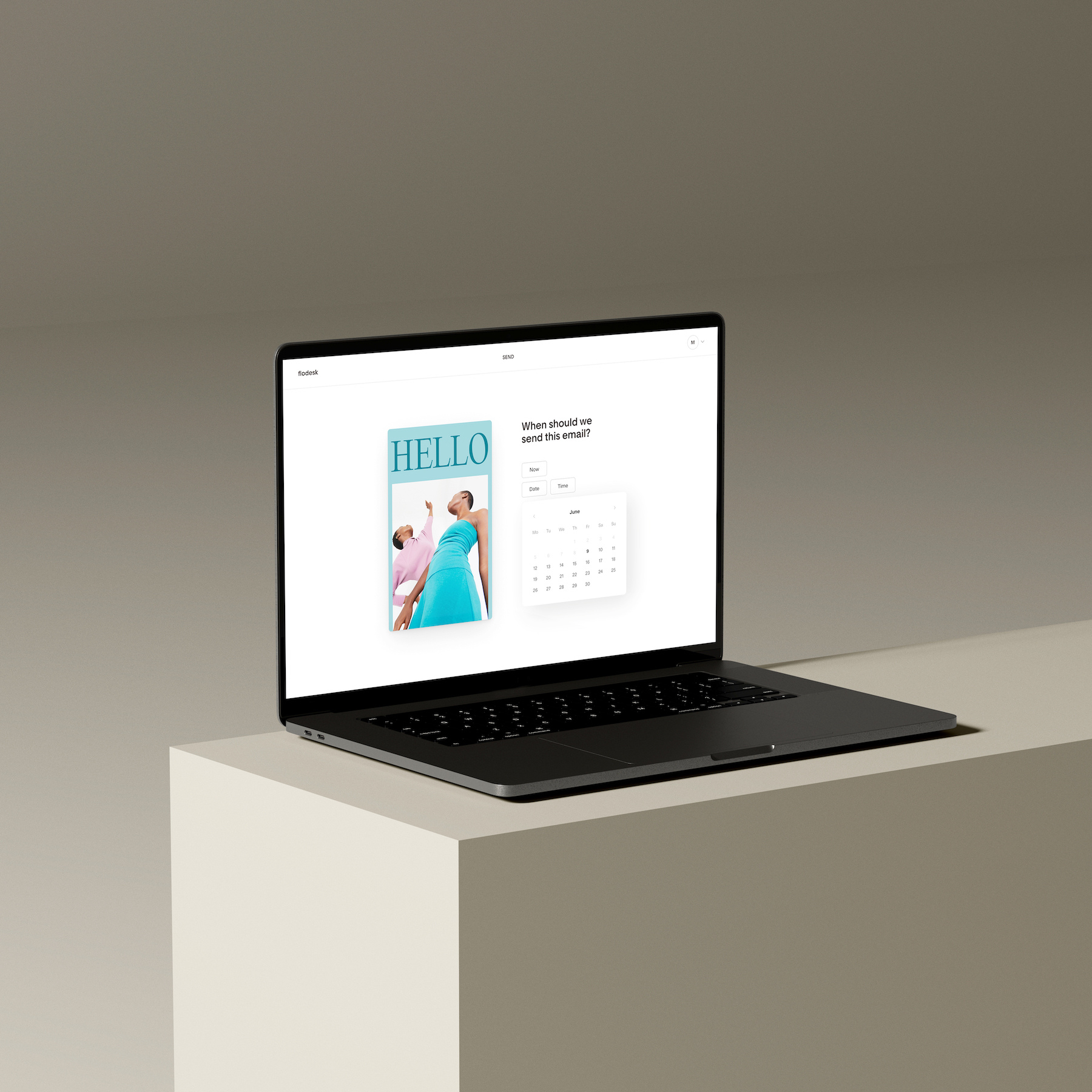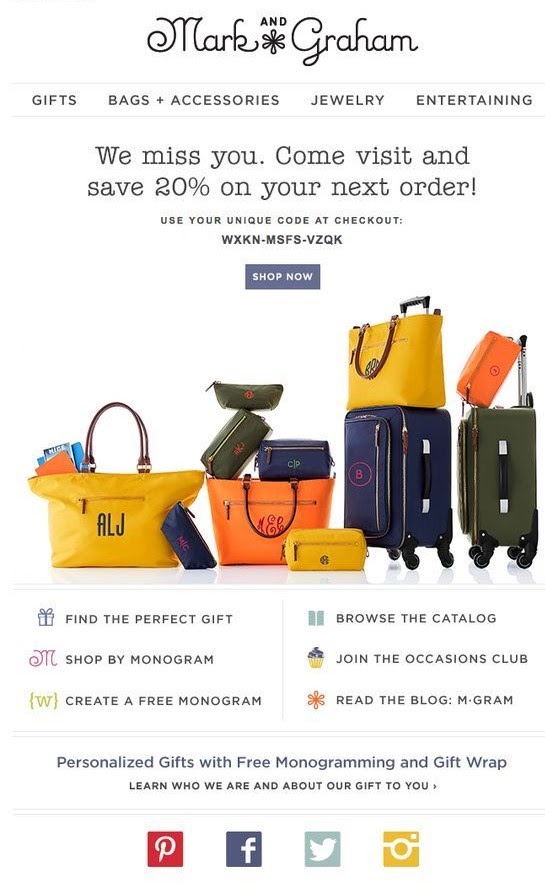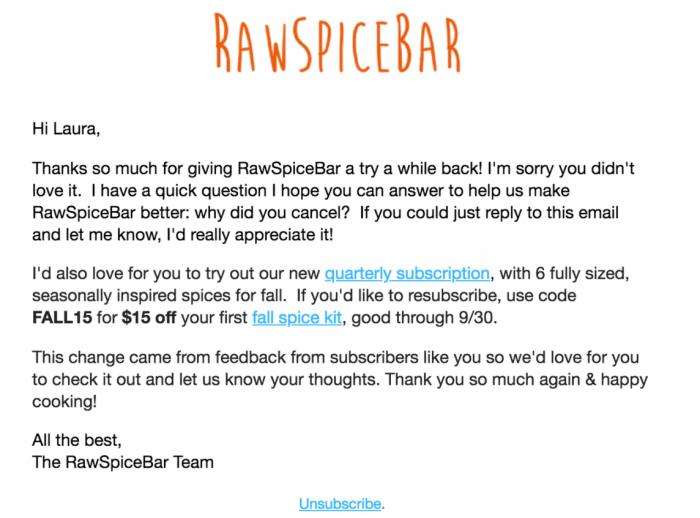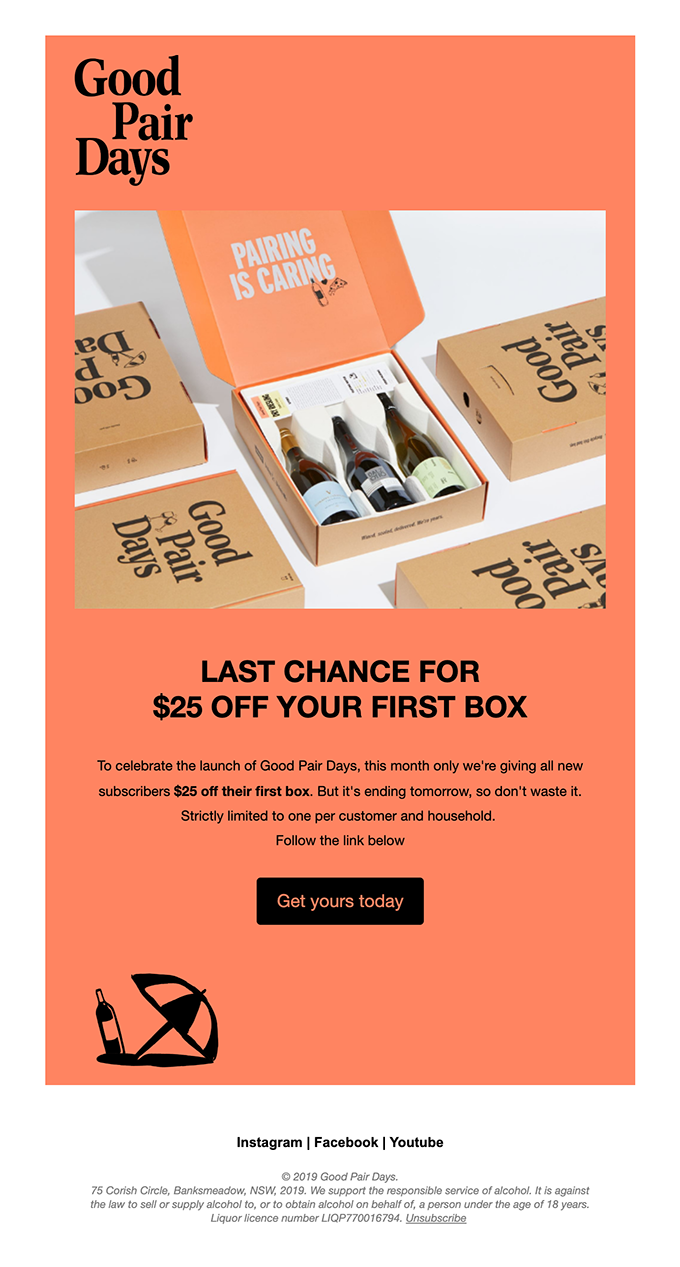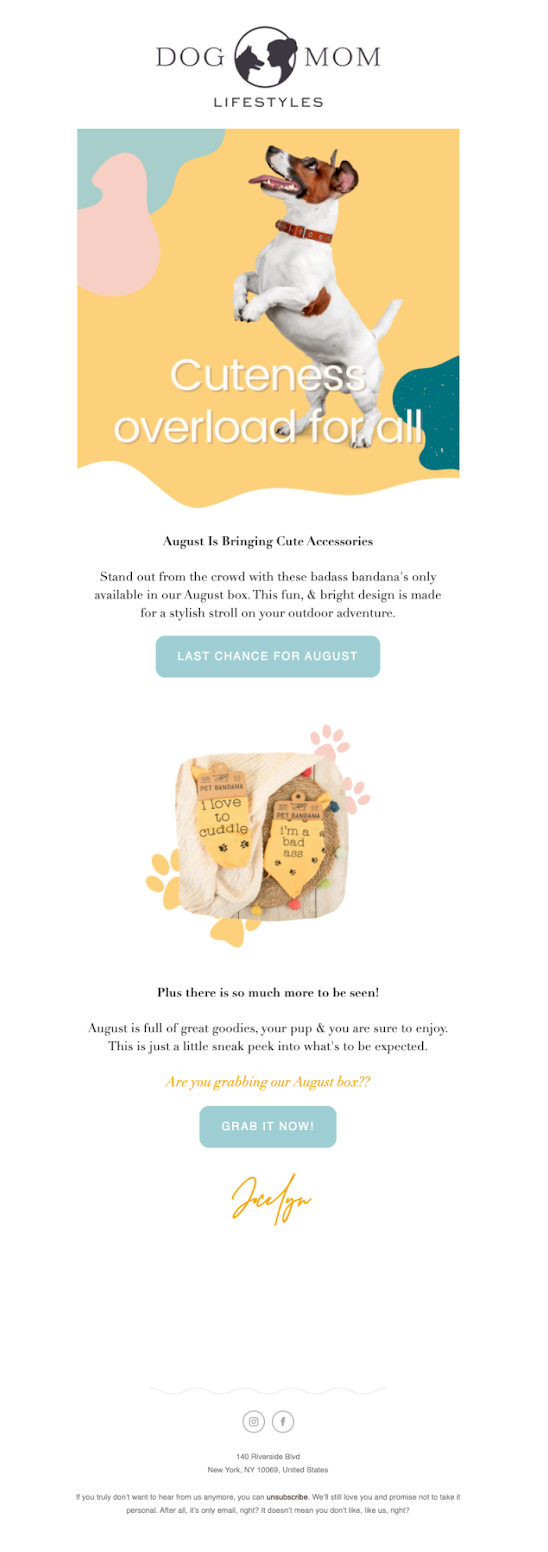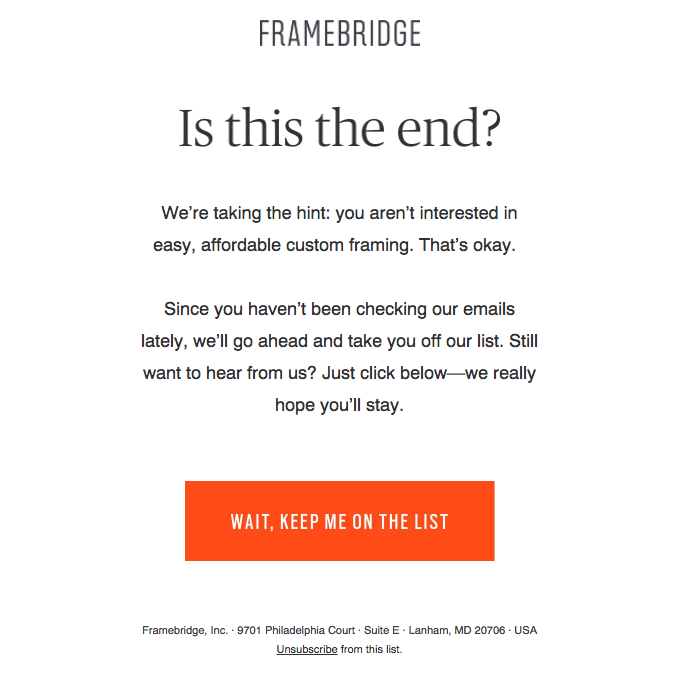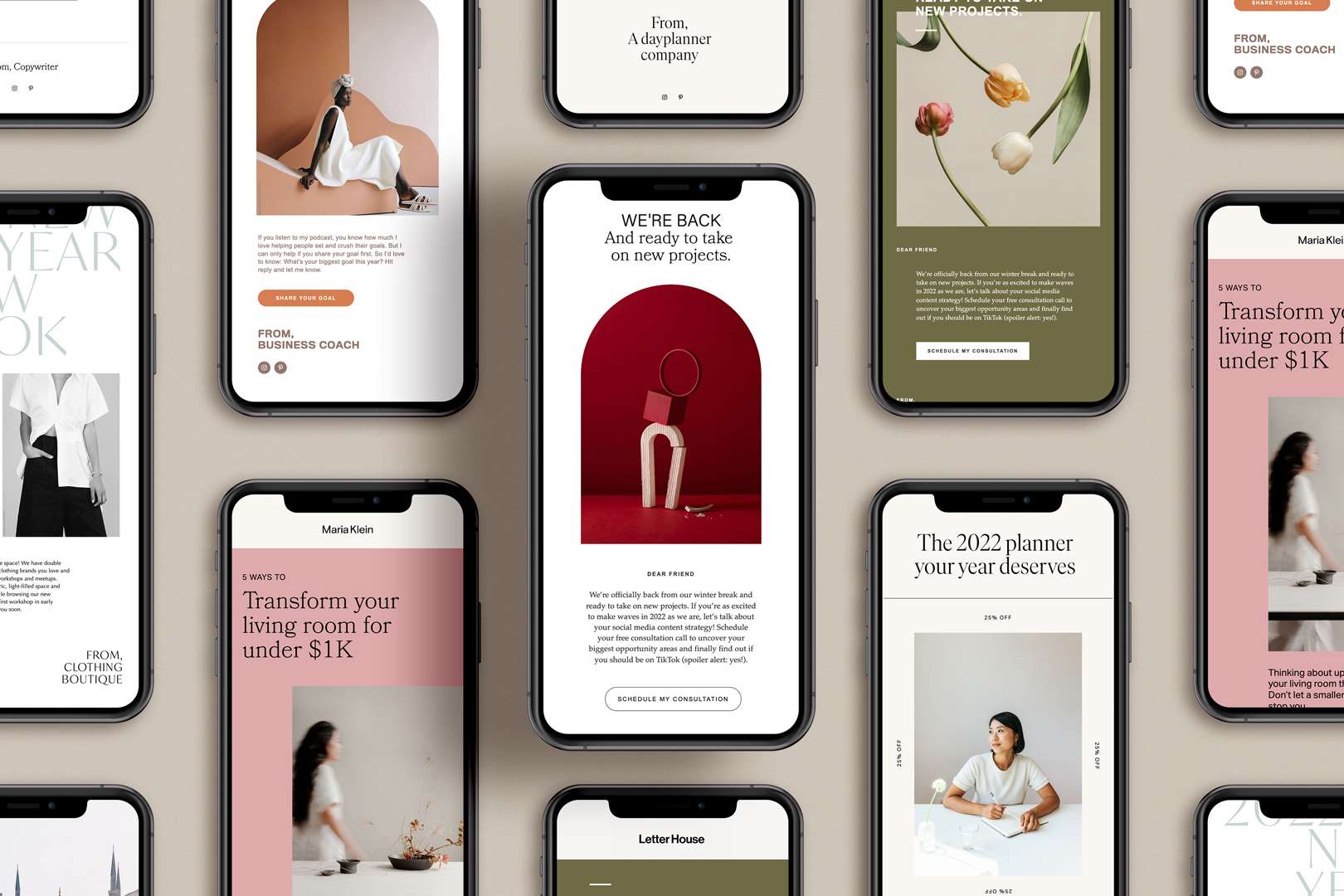11 Win-back email examples to draw customers back
Table of Contents Jump to:
Jump to:
Table of contents
Experts tell you it’s normal to lose a significant percentage of your customers and email subscribers each year. But, normal or not, you’ve got to admit it stings. Especially when statistics are showing that 65% of your revenue will come from existing customers. It’s just logical to want to hold on to them.
So, how do you stop customers from leaving? Great question. A well-designed, well-timed win-back customer email is just the ticket.
In this article, we’ll look at exactly what a win-back email campaign is when you should think about using one, and six stellar customer email template ideas you can use.
We’ll also dive into these effective win-back email examples to target disengaged customers:
1. Remind customers what they loved about your brand
2. Get back on track with a seasonal campaign
3. Provide an exciting incentive
4. Give exclusive sneak peeks or priority access
5. Collect feedback from your customers
6. Re-personalize your emails
7. Give your customers one last chance
8. Highlight product and service updates—even small ones
9. Instill a bit of FOMO
10. Offer a limited time free-trial or a sample
11. Let your customers know they’re unsubscribed
What is a win-back email campaign?
A win-back email campaign is a series of emails you create and design to re-engage inactive customers. It typically costs businesses five times more to attract new customers than to retain existing ones, which means winning back customers is vital to your business’ success.
There are steps you can take to reduce customer churn—the percentage of customers that stop using your product or service during a particular time period—when the perceived value that customers get from your product or service diminishes for reasons that you can do something about.
So the win-back email sequence is all about identifying why customers stop using your product or service and sending targeted emails to tempt them back into the fold.
Read next:
When is it time to send win-back emails?
So how exactly do you know when it’s worth investing time, effort and cash into a win-back campaign and who should you target with it?
Let’s look at three scenarios where win-back email campaigns are a good idea:
Lapsed customers
The first occasion when you’re going to want to try a win-back campaign is for lapsed customers. They are either those who used to buy frequently but haven’t made a recent purchase or those who made an initial purchase but haven’t become repeat customers.
You can attempt to re-engage customers before they become lapsed by following these timeline guidelines:
- A customer is losing interest after 90 days of inactivity
- There is a high risk of lapsing if a customer is inactive for 90-120 days
- The customer is considered lapsed if inactive for 120-80 days
The reasons for lapsed customers can vary, but the two most common are that the customer was unhappy with their purchase, or your product or service isn’t top of mind.
A “feedback” win-back email can be a useful first step in determining why a customer has lapsed and what you can do to win them back.
Top tip: Learn more about what your data is telling you, check out Understanding Your Flodesk Email & Workflow Analytics.
Seasonal customers
Sometimes, customers happily remain loyal to one particular company or brand but, for several reasons, don’t purchase frequently.
These reasons might include:
- Seasonal purchases, e.g., Halloween costumes, Christmas decorations, or winter boots
- Purchases linked to a particular occasion, e.g., a new shirt for a new job
- Purchases that don’t need frequent replacements, e.g., dishwashers or bed linen
- Purchases made to meet changing tech requirements, e.g., laptop upgrades once every five years
For these reasons, these customers don’t view themselves as disengaged. They are merely hibernating until the circumstances are right to make a repeat purchase. So make sure you personalize your win-back emails with this in mind
Inactive subscribers
An inactive subscriber is a contact on your email list who has never made a purchase but at some point signed up to receive newsletters, promotions, or other mailings from you. These people obviously found something of value in your product and service at the time but weren’t ready to make a purchase.
Over time, they’ve also stopped opening or engaging with your emails, and now’s the time to find out if you can reignite their lost interest or if it’s time to let them go.
Win back customers with Flodesk
Send win-back emails customers want to open with our intuitive templates, tailored to your brand
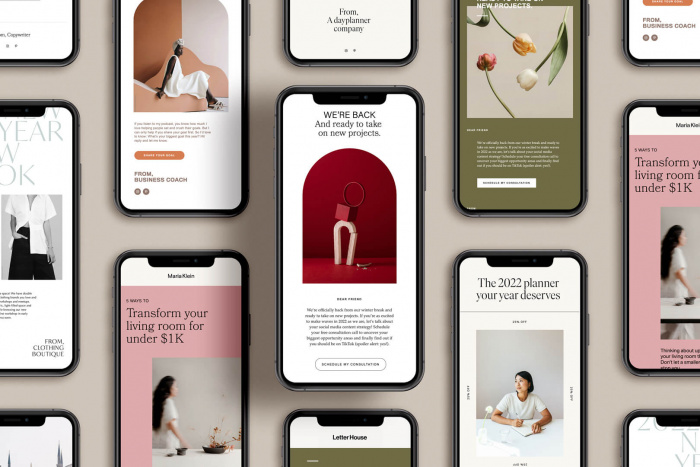
11 win-back customer email examples & templates
By now, you’re clear on what a win-back email is and when it’s most important to send one. The next step is to take action. In this section, we explain the six most common types of win-back templates and show some great win-back email examples.
Let’s get started.
1. Remind customers what they loved about your brand
In this win-back email, you can remind your customers what’s great about your product or service. At some point, they valued what you were offering enough to visit your website, subscribe to your email list or make a purchase.
You can use the reminder email as a prompt for customers to re-engage with you, so don’t be afraid to let them know what’s changed since they’ve been gone, including any feature upgrades.
Here’s a great example from the retailer, Saks Fifth Avenue:
Elements that make this a great “reminder” win-back email:
- Visual representation of high-end fashion to remind customers of their brand
- Takes advantage of FOMO by mentioning discounts and promotions
Need to remind customers what’s great about you? Here’s a template you can use to get started:
Subject line: Since you’ve been gone….
Hi [Name],
We’re going to go out on a limb here and assume you get as jazzed up about [product category/core feature] as we do. Right?
Okay…..maybe not quite as jazzed up. It is our thing after all. But, if you’re at all excited about [product category/core feature], then we’re on the same page.
Big things have been happening over here at [business name]. Here are a few highlights you might have missed since you’ve been away:
Highlight 1
Highlight 2
Highlight 3
If you’re thinking about giving us another try, there’s no time like the present to get started.
Sign Up Today!
P.S. Need a little extra love from the [business name] team? Schedule a call today [name] and we’ll help you.
2. Get back on track with a seasonal campaign
Maybe your content has just not been resonating with your audience enough. It’s been too generic, not relevant or in any other way has blended in with the rest of the messages in their inbox. Time for a revamp!
Jump on trends, seasonal changes, holidays, and other current topics to make your email campaigns feel more relevant to your audience, and use a fitting email design to reinforce your message. This is a great way to inspire people on how to use your products or services. Here’s a template that shows you how it can be done.
Win back inactive customers with this template:
Subject line: Our spring cleaning is done—is yours?
Hi there, [name]!
Spring is in the air, and we’ve cleaned out our inventory to make room for the new things that are coming.
We don’t normally do big discounts, but there’s this flowery smell in the air that just makes us want to give, give and give. 💐
Below you’ll see our best offers—get them before they’re gone,
[Insert offers]
Happy Spring!
[Your name]
3. Provide an exciting incentive
Offering an incentive is a great way to tempt customers back. People can’t resist a bargain—nearly 54% of internet users aged 18-29 said discounts were very important in influencing purchasing decisions. Your incentive could be a discount code, special promotions like “buy one, get one free” or a free trial of your service.
Whatever you go for, make sure it’s easy for your customers to take advantage of your offer. And be sure to place whatever incentive you’re offering in the subject lines of your emails to increase your email open rates.
Here’s an email example showing how personalized gift company Mark and Graham did it:
Why this is a great win-back email example:
- 20% discount is front and center
- Email showcases their best products
If you’re interested in mastering the “incentive” win-back email, here’s a template you can use to get started:
Subject line: 7 days free with [business name].
You know [name], everyone loves a comeback story.
So why not come back to us?
We’ve been working around the clock to build the best [core product/feature] in the game and we know you’ll love our latest updates. We believe in second chances, so we’re giving you another 7 days to see if [business name] is the right fit. No strings attached.
To activate your free trial:
Visit [website]
Action 1
Action 2
Get started and enjoy [core product/feature]
Start Your Free Trial
We hope to hear from you soon,
[Your name] and your friends at [business name]
Engage more customers with Flodesk
Create functional and beautiful emails in minutes with our email marketing platform.
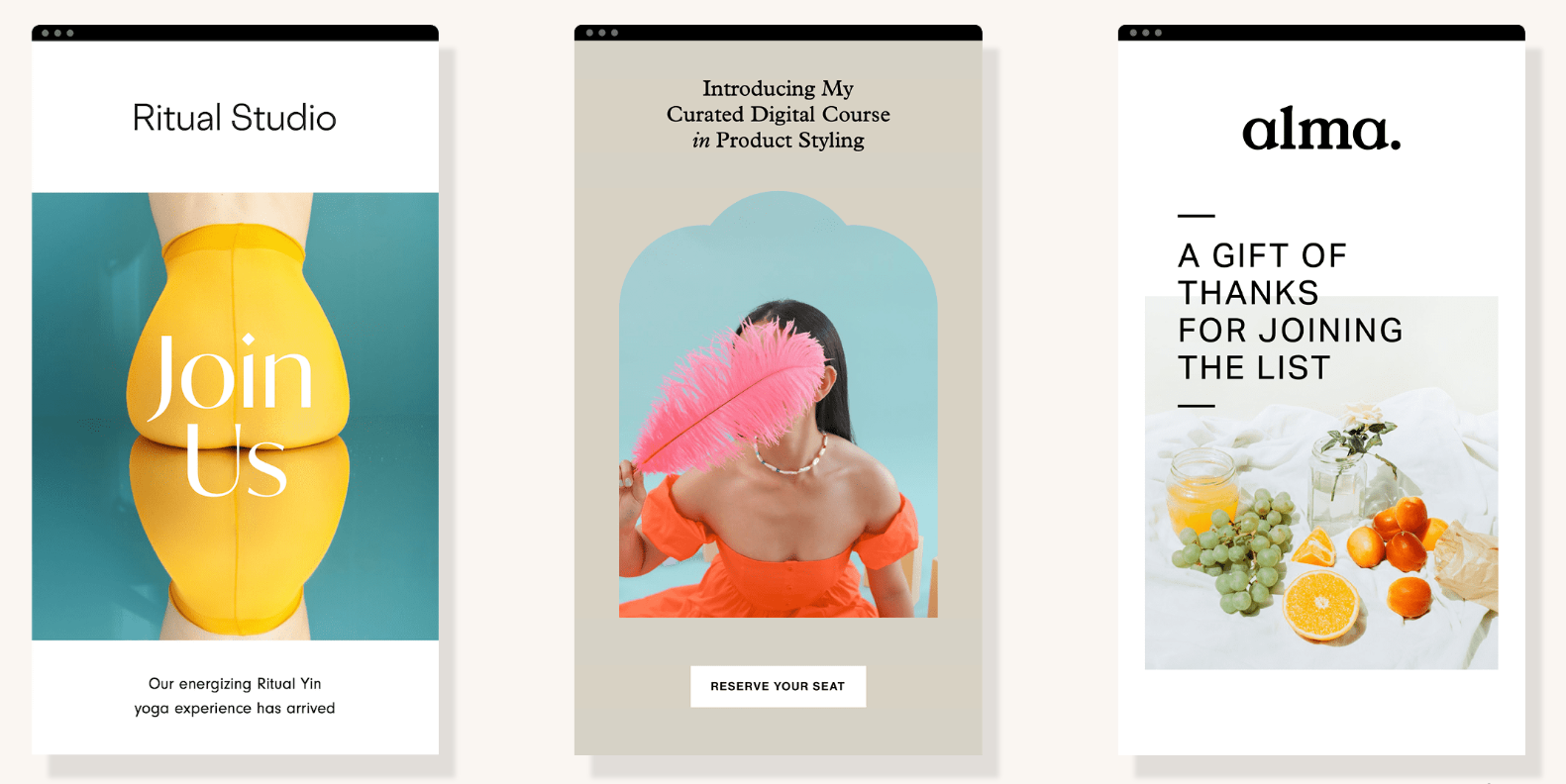
4. Give exclusive sneak peeks or priority access
Making your inactive audience members feel important and valued is one of the best practices for email list engagement. If you’re launching new products or services soon, show them what you’ve been working on. Let them know they will be the first ones who can access your newest goodies, preferably on top of a discount. Find out how to write a product launch email.
This creates both a sense of urgency and makes people feel appreciated. Really double down on the fact that only subscribers like them are getting priority access, for instance with a timesheet on when your product is released to different audiences.
Here is a template you can use for inspiration:
Subject line: pre-launch access starts tonight
Hi there [name],
We’re getting everything ready for the launch of our new release next week, but what’s a party without guests? We want to make sure you and your friends are in those front-row seats.
That’s why you’ll already be able to shop our products, starting at midnight tonight. This pre-launch sale comes at a 20% discount and will only be open until the big launch next week—when prices will go up.
See you there?
[Your name]
5. Collect feedback from your customers
Feedback, especially from customers who lost interest in your product, is hugely valuable. It allows you to pinpoint things in your business that are frustrating your customers or detracting from their experience.
Emails requesting feedback might prompt customers to share why they are no longer interested in your company, which gives you the fuel to try and re-engage them. Requesting feedback from your customers also shows that you’re interested in their opinion and want to do everything possible to satisfy their needs.
Here’s how the global spice subscription service RawSpiceBar does it:
What makes this a good win-back email example:
- The email is personalized with the customer’s name
- They take full responsibility for any reason as to why the customer is disengaged
Here’s a template you can use to gather feedback:
Subject line: What’s on your mind, [name]?
Hey [name],
It’s been too long.
We know that life gets busy and maybe [business name] isn’t fitting your needs the way you’d hoped.
At [business name], we strive to maintain awesome communication with our customers so we can keep getting better.
So tell us, what can we do to level up your experience? Choose an option below.
Address [issue]
Add [feature]
Provide more support
Reply to this email with A, B, or C (or all of the above) and we’ll provide personalized support to get you back up and running.
Talk soon,
[Your Name]
P.S. Got more to say? We’re all ears. Reply to this email with your feedback.
6. Re-personalize your emails
If your audience hasn’t been engaging with your brand because your content is off, it’s time to get to know them better—again. Send them a fun quiz to find out what they like. You can also be super upfront and say: hey, we sense that this isn’t working—let’s start fresh.
Maybe their taste has changed, or their needs. With an interactive email, you can find out what’s different and start sending offers and content based on that.
Of course, it does help if you have a benchmark and know what they previously liked and bought—so if you do, use that data to rekindle the love!
Dive into your email marketing metrics, and draw some inspiration from this template:
Subject line: First date questions?
Hey [name],
We feel like this love needs some rekindling. We’d love to get to know you again, so we can offer you the world (or at least our products that best suit you).
What do you say? We’ve created a fun little quiz….
[Insert quiz or link to quiz]
Yours truly,
[Your name]
7. Give your customers one last chance
This win-back email is a last-chance option for retaining this customer. However, just because this is the case, it’s definitely not an email where you want to get too pushy.
Offer a “last chance” for them to stay on your list or get something you’re offering. Make sure to reiterate that email is the best way to receive what you’re offering, your latest updates, and any exclusive content or discounts, but also make it easy to unsubscribe should they want to—so you don’t appear pushy.
This is what a “last chance” win-back email example looks like with online wine retailer Good Pair Days:
Why we like this last chance win back email:
- A time-limited promotion is tempting for customers
- The email design is visually appealing
Here’s a template you can use to create your own:
Subject line: Before we say our goodbyes…..
Hey [name],
We’ll take your silence as a sign.
We understand [business name] might not be right for you, so we’ll save your inbox from the extra emails and be on our way.
If you’d still like to receive updates on new [products/services] and exclusive discounts straight to your inbox—it’s not too late. We’d love to keep you around.
Keep me on the list
Best,
[Your Name]
You can design enticing win-back emails with the right tool—check out these Constant Contact alternatives to find the right one.
For more tips on connecting with your audience, read 3 Tips to Connect With Your Audience in Emails and Abandoned cart email examples.
8. Highlight product and service updates—even small ones
What if your inactive subscribers aren’t interacting or buying because they’re waiting on a specific product update or a change in your services?
If you’ve got faster delivery, incorporated product feedback, have new colors available, or anything else worth mentioning, let the world know! This could be that last push they need to actually purchase your products, or at least start browsing again.
Create your own win-back email with this template:
Subject: We heard you🎨
Hi [name]!
We don’t see the world as black and white. And now, we’ve adapted our products to that vision, too.
You guys have been sending in some cool color and design ideas, and we loved it all. So much so, that you can now customize our products to fit your style.
Try it out here.
Pretty cool, ha?
The first 100 people who order with their own design, will get a 30% discount, so get those creative juices flowing!
Happy customizing,
[Your name]
9. Instill a bit of FOMO
FOMO, or fear of missing out, is a real phenomenon—69% of millennials experience FOMO at least daily. And with millennial spending set to top $1.4 trillion this decade, it’s a strategy worth leveraging.
The “FOMO” win-back email uses this to hint to customers that if they don’t engage with a product or service, they might miss out on some incredible experience or cool product. The “FOMO” win-back email is especially successful when combined with a time-limited discount or promotion, which encourages customers to take advantage of the offer immediately or face losing it forever.
Here’s how dog treats subscription service Dog Mom Lifestyles uses FOMO to their advantage in their win-back email campaign:
Why this email works:
- The cute and colorful email design is on-brand and appealing to their target audience
- It offers a sneak peek of some of the goodies available in that month’s subscription coupled with a ‘last chance for August’ CTA
Want to use FOMO to your advantage? Here’s a template you can use to get started:
Subject line: [X number] people are using [business name] and this is what they had to say…
Hey [name],
It’s [Your Name] from [business name]
We noticed you haven’t taken advantage of your new customer discount yet so we thought we’d remind you exactly why [business name] rocks:
- Benefit 1
- Benefit 2
- Benefit 3
Okay, okay, we’re a little biased. But our customers aren’t.
[add client testimonial here]
Their words, not ours.
Want to see it in action?
Last chance to use your 15% [business name] discount today
Stay safe,
[Your Name]
Use fomo to your advantage with Flodesk
Don’t miss out — make customers remember why they subscribed in the first place with our easy-to-edit templates
10. Offer a limited time free-trial or a sample
Giving away freebies isn’t desperate at all—for high-value products or services, that’s exactly what people need. For some big investments, customers simply don’t want to base their decision solely on reviews or the word of others.
If your product or service falls into this category, try reactivating those sleepy subscribers with a truly free trial, a sample product, or a free call in which you give them tailored advice, if you’re a coach, for instance. If people don’t bite after this, they’re probably not interested in your products or services anymore, and you can start focusing your efforts on other audience members.
Use this template to get started:
Subject line: Free 30-minute coaching call
Hey there [name],
I know you’ve been eager to start working on yourself, but you don’t know where to start.
I also know there are a lot of tools, tips, and yes, even other coaches out there.
It’s a very personal choice, to find what works for you.
If you want a taste of what it’s like to be coached by me, let’s have a free 30-minute call. There’ll be no strings attached, promise. I just want to see if we’d be a match, and guide you in the right direction if we aren’t at this stage.
Book your call [here].
Really hope to speak to you soon!
[Your name]
11. Let your customers know they’re unsubscribed
If none of the above win-back emails work to tempt back customers, it’s time to focus your effort elsewhere. The “unsubscribe” win-back email lets your customers know you’re removing them from your subscriber list.
Like the “last chance” email, telling your customers you’ve unsubscribed them gives them a final chance to re-engage. Pop a clear call-to-action at the bottom of the email so they have an opportunity to resubscribe if they don’t want to be taken off the list.
Here’s how custom framing company Framebridge checks in with unsubscribers to check if they’re certain they want to leave their list:
Elements in this email that work:
- A large headline, “Is this the end?” lets customers know exactly what the email is about
- A visible and bold CTA button to entice people to stay
If it’s time to say goodbye, here’s a template you can use to get started:
Subject line: I guess this is goodbye….
[name],
We’re sorry things didn’t work out between us. No hard feelings though, we still think you’re great.
We’d hate to overstay our welcome in your inbox, so we’ve taken you off the list. The same list that [X number] subscribers have been receiving and loving!
If you have a moment to let us know what turned you away, reply to this email with your feedback so we can do better next time. We’d love to hear your thoughts.
All the best,
[Your Name]
P.S. Was this a mistake? Our bad. Click below to re-subscribe.
Keep me on the list!
How to create a successful win-back email campaign
You’re well on your way to creating convincing win-back emails. So, how do you wrap these emails up within a successful win-back email campaign? What other factors do you need to consider to have the greatest chance of winning your customers back? We’ve got all you need to know below.
Step 1: Figure out why they disengaged
It’s going to be tricky to win back customers if you don’t really know why they stopped engaging with you in the first place. Taking the time to figure out precisely what didn’t work for them means you can make sure that your win-back email targets that specific problem and shows you in a new light.
There are a couple of things to consider when trying to find out why customers disengage:
- Track when they stopped engaging and look for anything that changed about your business that correlates.
- Check if they’ve given any feedback or complaints via your customer service or social media.
Step 2: Create targeted win-back emails
Based on what you found out about why customers disengaged, create a win-back email targeting that specific problem. Were they unhappy with a feature that you’ve since updated? Tell them! Has there been lifestyle changes that your new product or service accommodates? Let them know!
Make sure you also personalize your win-back emails by doing simple yet important things like using their name. Personalization is critical, over a third of customers said they return to a brand that personalized their experience even if there were cheaper or more convenient alternatives. Additionally, you can leverage top email optimization strategies to ensure your emails shine bright in the inbox.
Step 3: Use eye-catching subject lines
47% of people open an email based solely on its subject line. So, it’s pretty vital that you get it right. Personalization is essential here, too, with targeted subject lines boosting open rates by 22%.
Your subject lines should reflect the content of your email and align with its purpose. Offering a promo? Put it in the subject line. Leveraging FOMO? Make sure your email header screams phrases like, “Don’t miss out!” Want to get their feedback? Put a question in your subject line. It’s human nature to want to answer what’s asked of us, so make that instinct work for you.
To learn more about how to tempt readers into clicking, read How to Write Click-Worthy Email Subject Lines.
Step 4: Choose the right time
It can be hard to decide when to send a win-back email. Defining when a customer has lapsed can have several variables and can differ by product and industry. So monitoring customer behavior can give you an idea of what’s typical for your business. As a benchmark, most experts recommend thinking about a win-back campaign after a customer or subscriber has been inactive for 3–6 months.
Make sending win-back emails easier by automating the delivery process. Set a trigger for a targeted win-back email to be sent after a certain period of time. Great email marketing platforms (hint: Flodesk) can make this process a whole lot easier, saving you time and effort better spent on other things.
Step 5: Focus on the relationship
Win-back emails are not the email for strong-arming or pushy sales pitches (in fact, no emails should be about those). The point of the re-engagement email is to offer something of value to your inactive subscribers to get them invested in your company again. Whether that’s something more obvious in an “incentive” email or more subtle, like seeking to address their pain points in a “feedback” email, make sure the focus is on making things better for them, not you.
Showing you appreciate your customers by offering them something of value helps build trust, which has a positive effect on customer loyalty and retention. Speaking of loyalty, check out our post on loyalty program emails!
Win back your customers with compelling emails
Lapsed customers are a fact of business life. But that doesn’t mean you have to wave goodbye to them. Targeted, well-timed win-back campaigns can make the difference between re-engaging customers and losing them forever and the above win-back email examples are a good place to start
Need a great email marketing tool to run with? Flodesk is the fastest-growing email marketing platform on the market, helping small business owners design emails people love to get. From stunning email templates to immersive forms, Flodesk’s template builder and email software makes it easy for beginners and experts alike to attract, keep and win back customers—all without a website.
Ready to win back those valuable customers? Try Flodesk for free—no credit card required!
